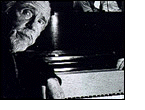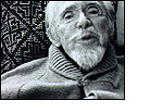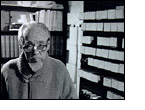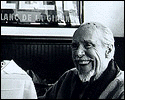By John Fago
October 29, 1997
All photos ©John Fago. Click for larger view.
 CONLON NANCARROW came to Telluride, Colorado in 1989 for the Telluride
Institute's second Composer-to-Composer Festival. It was my good fortune to
be the photographer for this event. The first time I saw him from across a
room, I knew he was someone I was going to like. His infectious smile was
quick to turn to laughter, and the genuine warmth and interest he brought to
every conversation made one feel instantly at ease, respected, and valued. He
was without doubt someone who had lived a very full life.
CONLON NANCARROW came to Telluride, Colorado in 1989 for the Telluride
Institute's second Composer-to-Composer Festival. It was my good fortune to
be the photographer for this event. The first time I saw him from across a
room, I knew he was someone I was going to like. His infectious smile was
quick to turn to laughter, and the genuine warmth and interest he brought to
every conversation made one feel instantly at ease, respected, and valued. He
was without doubt someone who had lived a very full life.
He had come from his home in Mexico City with his lovely and attentive wife,
Yoko, and was joined by that mad genius Trimpin with his Macintosh Plus filled
with digital renderings of Conlon's piano rolls which Trimpin had transcribed
using a vacuum cleaner. Trimpin also brought the long box full of carefully
mounted surplus gizmos and colorful wires which he bolted onto a piano
keyboard to perform Conlon's transcribed player-piano rolls on a regular
piano. It was a wonderful week, and at parting Conlon invited me to visit and
photograph him in his home and studio in Mexico.
 The following year (Sunday, October 28,1990), work took me to a remote part
of Mexico. On my way, I had a five hour layover in Mexico City. When I
called ahead from the states, Yoko told me that Conlon had been very ill, but
he was better, and they would love to see me again.
The following year (Sunday, October 28,1990), work took me to a remote part
of Mexico. On my way, I had a five hour layover in Mexico City. When I
called ahead from the states, Yoko told me that Conlon had been very ill, but
he was better, and they would love to see me again.
Their home is a very special place. Yoko answered my ring at the gate and
led me through the garden to the living room. Instantly, I felt myself to be
in the home of an artist. Mentioning this feeling, Yoko told me that Conlon
had done most of the building by himself during the 1940s. Conlon
came down the stairs unassisted - but slowly - to greet me. We spent the next
hours drinking peppermint tea and talking about a hundred things. I had
brought them prints of photographs I had made during their visit to Telluride
including a group portrait of the composers under a rainbow which seemed a
special delight for Conlon.
 I asked Conlon if we might visit his studio. He looked to Yoko and smiled.
She frowned and said it was much too cold, but Conlon had that twinkle in his
eye, and moments later we were headed down a corridor towards what had the
look of a door to a bank vault. Indeed, it was like entering a windowless
cavern; there was a stillness that seemed very unlikely to be found anywhere
in Mexico City. With no day or night, I asked if he often worked through the
night. Another smile to Yoko, and Conlon allowed as how that had often been
his habit. Sitting down at the desk he used for composing, Conlon said it
had been months since he had been in that chair. A work in progress was
spread across the desk, waiting.
I asked Conlon if we might visit his studio. He looked to Yoko and smiled.
She frowned and said it was much too cold, but Conlon had that twinkle in his
eye, and moments later we were headed down a corridor towards what had the
look of a door to a bank vault. Indeed, it was like entering a windowless
cavern; there was a stillness that seemed very unlikely to be found anywhere
in Mexico City. With no day or night, I asked if he often worked through the
night. Another smile to Yoko, and Conlon allowed as how that had often been
his habit. Sitting down at the desk he used for composing, Conlon said it
had been months since he had been in that chair. A work in progress was
spread across the desk, waiting.
After half an hour, we left the studio and visited the library which included
a vast collection of 78 recordings from all over the planet and much
literature and poetry. Being myself a tinkerer, in passing Conlon's fine
collection of well-used carpentry and mechanical tools I could not help
complimenting him. With a sigh, he allowed as how though they'd been good
friends, he hadn't much use for them anymore. On her insistence, Yoko kindly
drove me back to airport just in time for my flight. I wondered if I would
see Conlon again.
 Conlon did finish the piece which had been spread across his desk and he
brought it to the Other Minds gathering of composers in San Francisco in
1993. Happily, at Charles Amirkhanian's invitation, I was the photographer
for this event as well. It was another memorable week.
Conlon did finish the piece which had been spread across his desk and he
brought it to the Other Minds gathering of composers in San Francisco in
1993. Happily, at Charles Amirkhanian's invitation, I was the photographer
for this event as well. It was another memorable week.
Sometimes one has the good fortune of spending some moments in one's life
with a special spirit one hopes to cross paths with again.
John Fago
Bethel, Vermont
October 18, 1997
Back to Otherworldly Compositions for Player Piano